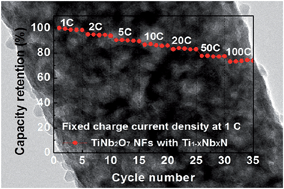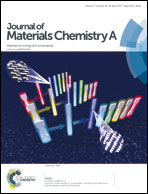Porous TiNb2O7 nanofibers decorated with conductive Ti1−xNbxN bumps as a high power anode material for Li-ion batteries†
Abstract
Titanium niobium oxide (TiNb2O7) has been reported recently as an attractive anode material for lithium ion batteries due to its practical capacity of ∼280 mA h g−1, which is much higher than those of well-known metal oxide materials such as TiO2 and Li4Ti5O12. However, low electronic conductivity and poor lithium diffusivity limit its practical use as the active material in lithium ion batteries. Here, we synthesized porous TiNb2O7 nanofibers decorated with Ti1−xNbxN bumps via electro-spinning and thermal ammonia gas treatment. As-prepared nanofibers have one-dimensional geometry with an average diameter of ∼110 nm, and consist of ∼70 nm crystallites and pores in the range of 0–40 nm, shortening pathways for Li+ ion migration into the host material. Furthermore, conductive Ti1−xNbxN bumps with a particle size of ∼5 nm were formed on the surface via thermal ammonia gas treatment which render fast electron transport along the longitudinal direction. The fibers have a specific discharge capacity of ∼254 mA h g−1 at 1 C and a superior rate capability (∼183 mA h g−1 at 100 C). They also show a robust cycle performance over 500 cycles. These dramatic achievements are attributed to heterogeneous nano-structuring creating a porous structure, and the conductivity of the metal nitride achieved by optimal synthetic conditions.


 Please wait while we load your content...
Please wait while we load your content...